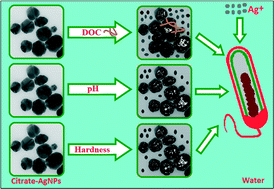As nanotechnology continues to develop at a fast growing speed, more research efforts should focus on the assessment of nanotoxicity in order to better understand whether engineered nanoparticles (ENPs) pose hazards upon exposure. ENPs have been used in a large variety of products (from toothpaste, soap, sunscreen lotion to plastic ware, electronics, cement, paint, etc.) and therefore the likelihood for ecological exposure to these nanoproducts in relation to their leachable by-products is inevitable.
Dubey and co-workers highlight the importance of assessing the interaction of ENPs with naturally occurring colloids in relation to environmental factors. Upon entering the aquatic system, these factors could modify their colloidal stability and ultimately affect their toxicity. Their studies focused on silver nanoparticles (AgNP) which have been widely used for their broad spectrum of antimicrobial and plasmonic properties. In particular, Dubey et al investigated the potential effects of multiple water chemistry on the colloidal stability, dissolution rate and antibacterial activity of citrate-coated silver nanoparticles (Citrate-AgNPs) against Escherichia coli. Concomitantly, toxicity studies of Citrate–AgNPs and AgNO3 were also performed in the river water samples collected across three seasons.
The work carried out by Dubey and co-workes underlines the importance of evaluating aquatic toxicity of ENPs in order to understand the potential implications on the ecosystem’s health and functions.
Read the full article for free!
Natural Water Chemistry (Dissolved Organic Carbon, pH, and Hardness) Modulates Colloidal Stability, Dissolution, and Antimicrobial Activity of Citrate Functionalized Silver Nanoparticles
Lok R. Pokhrel, Brajesh Dubey and Phillip R. Scheuerman
Environ. Sci.: Nano, 2014, Advance Article
DOI: 10.1039/C3EN00017F
Fancy submitting an article to Environ. Sci.: Nano? Then why not submit to us today or alternatively email us your suggestions.











